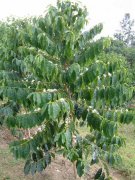Cultivation techniques of small-grain Coffee
Disease control:
1. Coffee rust is the main disease of coffee, which is the most harmful. The injured plants, light ones reduce production and heavy ones die. Coffee rust mainly affects leaves, but sometimes young fruits and shoots. After leaf infection, many small pale yellow spots appeared at first, and expanded like water stains, orange powdery spores were immediately found on the back of leaves, and light green halo circles were around the spots. Later, the spots gradually expanded or connected together to become irregular spots. The spots finally dried up and became dark brown, and the whole infected leaves fell off.
Control methods:
(2) Choose rust-resistant varieties for planting. In the introduction of strict quarantine work to prevent the spread of germs.
(2) Strengthen tending management to improve plant disease resistance.
3. Remove pathogens. Nursery seedlings should be regularly inspected to remove sick leaves; coffee plants should be pruned to remove weak branches and sick leaves, especially before the end of the dry season, and once sick leaves are found, they should be immediately removed by human organization and combined with chemical control.
④ Chemical control. 1%~5% Bordeaux mixture is sprayed, the first time should be before the rainy season, according to the specific situation and the severity and degree of the disease, generally every 2~3 weeks, triadimefon has a preventive effect on coffee induced disease, and has a therapeutic effect in the early stage of the disease. 35~ 65g of 25% wettable powder or 150~ 300g of 5% wettable powder are sprayed with 30kg of water per mu.
Coffee anthrax occurs in almost all coffee growing areas. It mainly injures coffee leaves. After the initial infection, the upper and lower surfaces have pale brown spots with a diameter of about 3 cm. These spots are grayish white in the center and completely gray in the later stage, with concentric circles of black dots. Infections also often begin at the leaf margin. The disease can spread to branches and fruits, causing branches to dry; fruits infected with the disease have black sunken spots, hard flesh and close to the beans.
Important Notice :
前街咖啡 FrontStreet Coffee has moved to new addredd:
FrontStreet Coffee Address: 315,Donghua East Road,GuangZhou
Tel:020 38364473
- Prev

Planting and harvesting of coffee
The first people to drink coffee lived in Ethiopia. A drink called Buncham was found in the Arab scientific literature of 900-1000 AD, but it is not certain that it is coffee. These documents mainly record the scientific value of this bean called Buncham. In addition to introducing the protective effects of this drink on the stomach, organs and skin, the author also mentioned that it can make
- Next

Real picture of the process from coffee tree to harvest
The coffee tree is more than 3 meters tall. Coffee flowers white flowers, beautiful like magnolia, but life is short, it will wither after 3 days! After the coffee beans are in full bloom, the coffee beans turn from green to red and when the fruit is bright red and ripe, you can begin to pick and harvest the fruit, remove the skin, soak it in water for 12 to 16 hours, and then wash it. Remove the peel of coffee beans
Related
- Beginners will see the "Coffee pull flower" guide!
- What is the difference between ice blog purified milk and ordinary milk coffee?
- Why is the Philippines the largest producer of crops in Liberia?
- For coffee extraction, should the fine powder be retained?
- How does extracted espresso fill pressed powder? How much strength does it take to press the powder?
- How to make jasmine cold extract coffee? Is the jasmine + latte good?
- Will this little toy really make the coffee taste better? How does Lily Drip affect coffee extraction?
- Will the action of slapping the filter cup also affect coffee extraction?
- What's the difference between powder-to-water ratio and powder-to-liquid ratio?
- What is the Ethiopian local species? What does it have to do with Heirloom native species?

